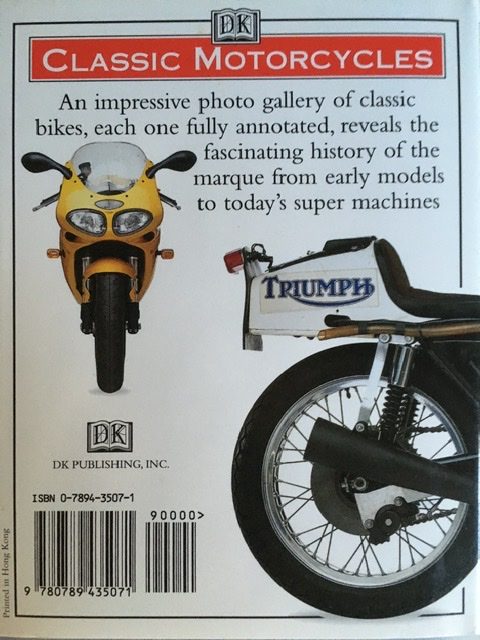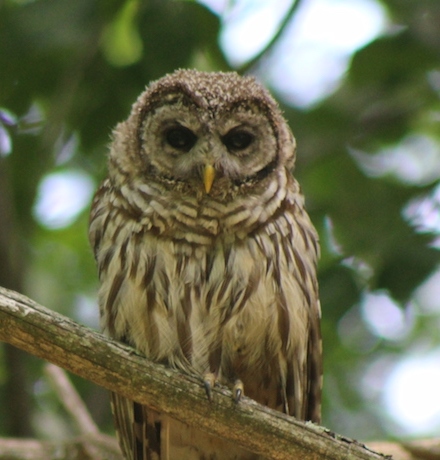Motorcycles came into my life fairly early because a neighbour at our house on Fraser Street, Shaw called Jack Fielding had a son whose name I cannot remember [3 years after writing this, I remembered that his name was Trevor], but he owned a motorbike. I think that it was a Triumph, though sometimes I recall a more exotic model like a Vincent. It used to make a lot of noise in the alleyway behind our home. In the 1950s motorcycles were either regarded as a toy for the rebellious youth or a means of transport for the working classes. In the latter case many bikes were often used with sidecars, some of which were very large such as the “Canterbury”. Many people will know that Jaguar cars for instance started out as a motorcycle sidecar company (called “Swallow Sidecar” or SS). Some bikes were also made with sidecars in mind; the most obvious was the Panther – a single cylinder 600cc slow-reving high torque machine. Bikes aimed at sidecars were also made by the big name manufactures based on their solo models. By the mid-1960s the Triumph Thunderbird had become the most sedate of their 650cc models and was often used to pull a “chair” as sidecars were often called.
My first motorcycle was a 1960 Triumph Tiger Cub, 200cc. Registration number XDK 920. I was eager to start using it and had become very keen on the idea of being able to get anywhere whenever I wanted to go. It was one of the best things that I ever bought. I still have dreams about owning this machine and it was the start of an instinctive feel that I have for British motorcycles of that era, even now, 55 years later. I wish that I still had a photograph of it, I certainly had one once, but I have searched high and low for it, however, there are many pictures of similar machines on the internet. This bike was bought with money given to me by my grandmother. She had always wanted a car and saw this as a means of getting me on the track towards motorised transport. It cost us £69 from “St Domingo Motors” in Oldham and was in excellent condition. My friends thought that I had overpaid, because we could have obtained a cheaper model though a private sale. It had a plastic box on a rack at the rear and I stuck a label on that said “Caution Air Brakes”. It was the “touring” version and had various bits of metal that enclosed much of the sides behind the seat tube. It might have been a 1961 model first registered in 1960. Unlike in the USA, in the UK at that time it was the year that vehicle first took to the roads that mattered not the manufacturer’s model year.
A Cub was just like mine:

I was the first person in my family to own and operate a motor vehicle, if you do not include my Mother’s brother, Uncle Fred Ashton, who had bought a Honda 50 as a means of getting to and from his work. I suspect that Uncle Fred had encouraged my grandmother to help with the cost of the Tiger Cub.
My parents had always considered a car as a rather expensive luxury and as mill workers it would have been very difficult for them to buy and maintain one at that time. Although at some point in my childhood my dad had taken driving lessons and had never taken the test. His reason was that he did not like being in charge of a machine that could kill someone. So we always used buses, trains, walking or very often bicycling.
Actually Uncle Fred had allowed me to ride the little Honda illicitly on a few occasions. He was always nervous about my being caught by the police though because he had been a town councilor (AKA selectman) for many years and was a governor of my school – Chadderton Grammar School for Boys. The Honda was very slow, but a reliable means of making short journeys. It had an automatic clutch mechanism and a heel and toe gear change on the left hand side which was not the standard for motorcycles made in England. I had fun on that bike and it gave me some confidence for buying something of my own when old enough. At that time it was possible to get a provisional licence at age 16, but there was a size limit of 250cc. I seem to remember that riders had to be over 17 to operate anything bigger than this, unless a sidecar was attached.
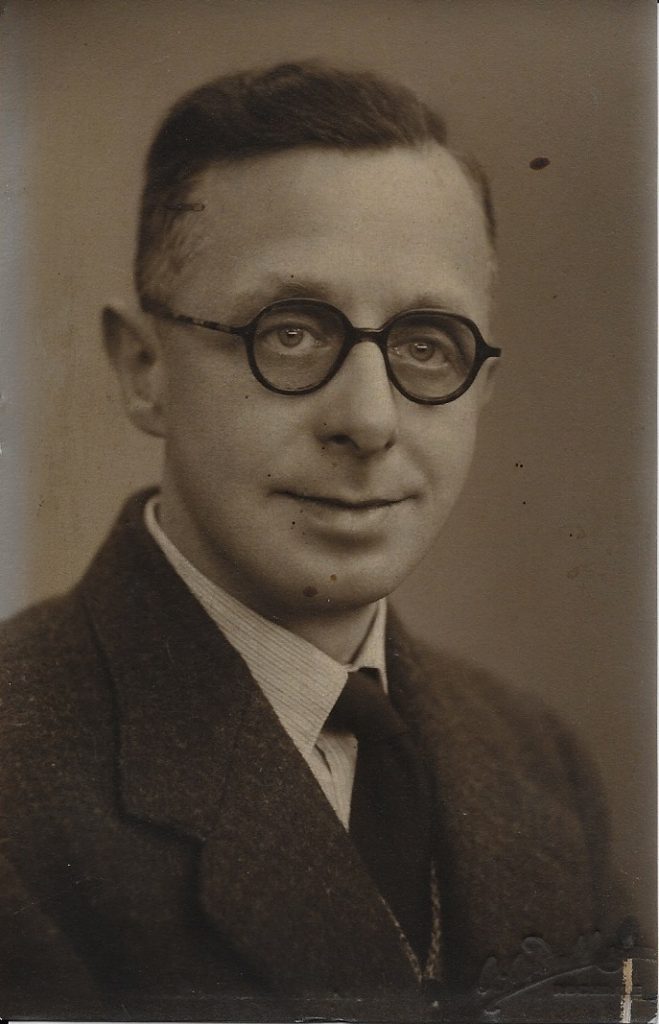
At the time several people from School had bought mopeds because if the engine was < 50cc and the bike had pedals 16 years olds could operate them, The most common were French – Mobylette was a popular model, but the British Raleigh Runabout was another well known marque. Some people even had 3-wheel cars which could be driven on a motorcycle licence, The Bond used a 250cc Villiers 2-stroke motor so a 16-year old with a provisional licence could drive it solo.
I don’t know why the world outside the UK used the left foot for gear change, but my theory is that it had much to do with the biggest market being the USA and other countries where the standard was to drive on the right hand side of the road. At that time motorcycles did not typically have direction indicators and hand signals were the standard. A left turn from the right hand side of the road when operating the clutch with the left hand could require some ungainly and possibly dangerous juggling with controls. Of course the opposite would be true in British Commonwealth countries which in general drove on the left hand side. British bikes changed when direction indicators became standard in the 1970s after which time the hand signals issue was no longer important, but meeting accepted international standards was needed. By then the Japanese motorcycle industry was dominant.
The Tiger Cub was great. It was reliable, easy to maintain and cheap to operate. I could go anywhere and did!
The first priority when a beginner on a motorcycle was to learn how to ride it. As my parents had no experience of motorcycles, this was a trial and error activity and since I was only 16 years old I was not exactly cautious. My friend Peter Dryden had a 250cc BSA C15. He once commented that I was a “peculiar driver” because of my use of the gears. Eventually though I learned how to ride properly and on the 15th of December 1965 I took the driving test at the test centre in Oldham, Lancashire and passed first time. The test was easy. The emergency stop was a joke – at some unexpected moment the examiner was expected jump into the road and I was supposed to stop quickly. Well the examiner was obviously nervous about this because he jumped out well ahead of me. So far in front that I just rode up to him and stopped normally.
About this time I had an accident. It was soon after getting my licence. It’s a long story, but it was not my fault and I had to give evidence against the driver in court – he received a ticket. However I had emergency treatment i hospital followed by physiotherapy for several weeks. The result is that I have a stiff index finger on my left hand and a permanent damage to my left knee that very occasionally gives me trouble. The stiff finger has stopped me from learning to play the guitar and any musical instrument where a tight control of the left hand is necessary and the knee issue only became a problem when I had a ski accident in 1987. In general though these injuries have never caused any trouble for me. I have been told that me years of being an enthusiastic bicyclist helped my knee.
Anyway I recovered and so did the bike. Even though it was written off by the insurance company, repair was successful. It became a passport to new friendships and many trips to the English Lake District. Although I dropped it once more when the car in front of me stopped suddenly in slippery conditions (the driver leapt out and was gushing with apologies).
I rode the bike everywhere and stopped using the school bus. We were allowed to park motorcycles and scooters near the bicycle shed during the day – there was no room for cars. Also allowed was a bubble car belonging to my friend Gordon Potts.
There were other “moments”. On one occasion I set off to the Lake District for a few days and was on my usual route which was to go through Central Lancashire to the A65 and the Ingleton area. I was heading out of the Nelson and Colne region when the nipple at the end of the throttle cable broke off. I had to abandon the trip and ride home by pulling the cable directly instead of using the twist grip. Fortunately I was able to get a new cable easily and get back on the road promptly. On another trip to the Lake District there was an enormous rainstorm and the road past Thirlmere was flooded. It was closed to cars, but I was able to splash through the water on the Tiger Cub – it created a huge wave out on both sides.
Then there was the occasion when the bike was stolen while I was in a phone box in Oldham town center. I called the police immediately and the thieves were caught later that evening when they were trying to steal another bike. The front brake cable had become disconnected on mine. There was a funny side to this bike theft – when the Police came to tell me that they had found the bike and apprehended the culprits, they told me that the front brake wouldn’t work, but that they would provide a police escort for me to drive home. So in the middle of the night I was led home on my little 200cc motorcycle by a monster police car.
On another occasion my Belstaff Trialmaster jacket was stolen and my licence was in the pocket. All very annoying, but I obtained replacements for both. A few weeks later the police came to our home in the middle of the night. My parents answered the door and were told that I had been picked up driving a stolen car in Manchester. My mother said “he’s upstairs in bed”. It turns out that my stolen licence had found its way to some car thieves that had tried to pass it off as their own. They cannot have been very bright because not only was my name on the document, but also it was only a motorcycle licence and I was not authorised to drive cars at that time!
The more I think about those days, the more I realise what a free-spirit I had become. I was quite happy to load a tent on the passenger seat and ride off to the Lake District for a hiking trip. On one week four of us went to North Wales for a stay at a Butlins Holiday camp.
Motorcycles became a major part of my life and at one point during my final year at school when all science students were required to take a course in workshop practice a group of us including Peter Dryden obtained a 1938 350cc single cylinder Ariel engine with the objective of rebuilding it. Some students went for go-karts and other things, but this suited us. We dismantled the motor and we had to build a side-valve valve spring compressor for ourselves. Anyway we never finished the project and the motor was left at the school when we departed at the end of our final year there. I have not idea what happened to it – perhaps the next year’s students finished the task.
I gave up the Tiger Cub about the time that I went to University. In fact I sold it to a friend of mine. By then, it had a dodgy clutch that I had tried to repair (badly). I always found that the old multiplate clutches were a pain. I seem to remember that the clutch issue did not endear me to him or his girlfriend. As my second university year came along I was allowed to keep a motor vehicle on college grounds, so I decided that since the trip to Royal Holloway College involved a long journey by train I would invest in a larger bike that was suitable for the 200 mile trip. My cousin found a 1954 BSA A10 that had been rebuilt to some extent by one of his friends. It cost £30. For a while it was OK, but eventually the crankshaft broke. At the end of the year I gave it away to a fellow student that lived near college. I always liked the BSA bikes and the A10 in particular was a good looking machine so it’s a pity that this one did not work out. However it was fast and it’s the only vehicle that I have driven at >100 mph. It was on the M1 motorway returning from college.
Riding in winter from college was very cold. I had lots of warm clothing and could never keep my toes warm. Soon I inherited some money and was able to contemplate buying a car, but motorcycles were in my blood by then and ever afterwards I have hankered for another one, but never quite summoning up the commitment or the confidence to get one on the road. That did not stop me from buying them though. After I left Royal Holloway, I was at a loose end and a good friend of mine called Pam Tinckler was a motorcycle fan connected me to a 1960 Triumph Thunderbird. I bought it for £25. Soon after she married her childhood sweetheart and changed her name to Haughey at which point we lost touch until 2010 when she found me on Facebook and we are in contact again. This bike had a lot going for it, but I was trying to get a career started and moved to London in early 1972 so I sold the bike to a distant relative called Steven Bidwell. I think he put it on the road.
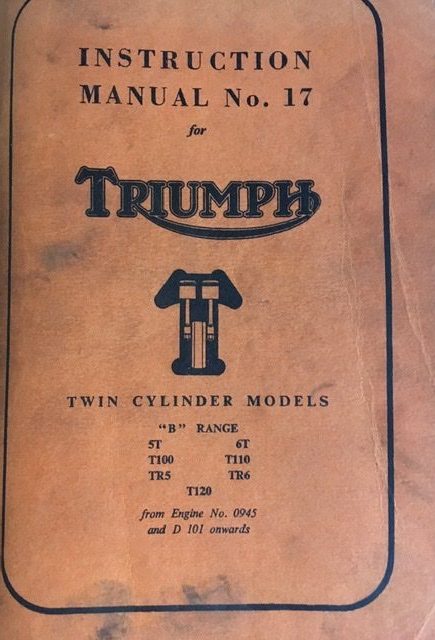
While in London I became friendly with my boss, called Rob Raisin. I learned that he had ridden across the Sahara on a 350cc BSA. At the time he had a Norton 600cc Dominator; age probably early 1960s that was sitting around doing nothing. It was not running, but seemed mostly OK. Nortons were the great competitors to Triumph. They had the famed “Featherbed” frame which had superb road holding. Triumph had sporty motors. I couldn’t resist this, so I bought it for £30 in 1973 with the objective of fixing it up. It was just after I moved back to Manchester. This was another vain attempt to get back on to motorcycles. I pulled it apart and made a lousy job of painting it, but never finished the refurbishment and this was sold through my second cousin to a friend of his (it might even have been Steven Bidwell again). I think this person had ideas of putting a Triumph motor in it; a popular thing to do in those days – kits for that purpose were readily available and the bikes were known as “Tritons”.
That Norton was the last motorcycle that I owned, but the bug never went away. I still have a licence that was transferred to Massachusetts in 1986. In the last several years I have been tempted to get another bike, but never actually did anything. There was a 750cc Triumph Trident for sale in Bolton during 1997 where I really came close to a purchase, I looked at a pile of disassembled BSA A65 parts in Littleton Massachusetts in about 2011 (the owner promised to get back to me when he was ready to sell, but never did). Recently, in 2019, I looked hard at a BSA Thunderbolt in Concord Massachusetts, but couldn’t get myself to buy it. I saw a very nice Triumph TR6 in Woburn Massachusetts in the Spring of 2020, but again I could not summon up the confidence to take the plunge.
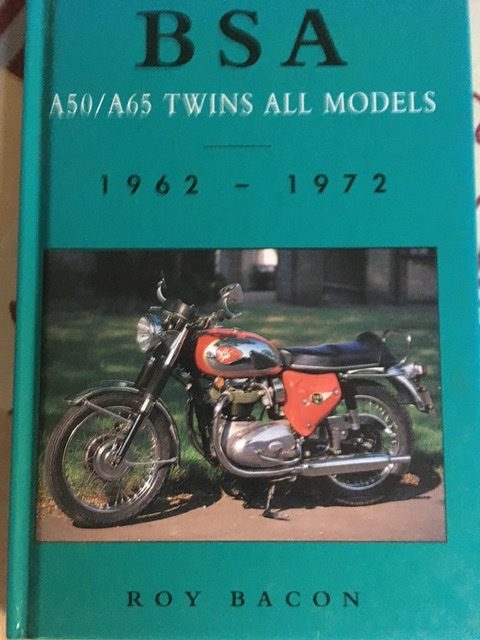
Now the issue is really that at 71 years old I’m not confident that I am quick enough to be able to ride defensively to the extent that motorcycling requires, but it would probably be OK on Sunday mornings for a quiet potter near home. Maybe eventually I will get back on 2-wheels, but I have a full life and don’t really need more hobbies Having said that you never know; I was never one for staying in my comfort zone. If I get another one it would have to be a late 1960s Triumph or BSA. 1969 was a good year for the 650 models. That vintage had better electrics than earlier models and the more effective twin-leading shoe front brakes. I never liked the later machines. Even though its owners love it, the Norton Commando was ugly in my opinion and it did not have a Featherbed frame – I could not bring myself to like a Norton without this. The oil-in-frame 1970s Triumphs and BSAs never instilled any enthusiasm.
The only marques from the golden years of British motorcycles that still exist with a large presence are Triumph and Royal Enfield. The Norton and BSA names have been bought and sold with varied success at resurrecting the marques and are both now Indian-owned, but by different companies. Bikes with the Norton name are being made in England again, but in small numbers I believe.
The only common link between the new Triumphs made after the company’s relaunch in 1991 is the name. It was bought after going out of business by an entrepreneur who built a brand new factory and developed up to date and very competitive models. The original Meriden factory has been demolished and the site is now a housing development where the streets have names from the glory days of Triumph like “Thunderbird”, “Bonneville” and “Tiger”. The new incarnation of Triumph has been very successful. Goodness knows what has happened to the old BSA factory at Smallheath, Birmingham.
Having shut down in England, Royal Enfield continued to make models that were first built in the 1950s at their Indian factory that was a relic of the British Raj, but the company has now developed a completely new range that’s sold in many countries and is highly regarded. Royal Enfield is the only one of these companies that is still directly descended from its original roots. Names like Matchless, Scott, James, Villiers, Ariel, Velocette, Sunbeam, Vincent have long gone. However, AJS seems to have survived in some form with a limited range of products. Other low-profile names that are still around in some form or another are Greeves and Hesketh. The latter was a creation of Lord Hesketh in 1980 and although the original company was less than successful the name seems to have survived.
You never know – I might get a bike eventually. If I do, I will take one of those training classes. Occasionally I look to see if I can find a Tiger Cub for sale. Decent ones are almost impossible to find in the USA, but they can be found in the UK. The going price seems to be in the £3000-£4000 range. 650cc Triumphs and BSAs are easy to find though and the temptation to buy one might get the better of me eventually. At one time, Triumph had an assembly plant in Indiana, which probably explains why they are so common in America.
Some of these old British brands have interesting history, the Triumph brand is related to Triumph cars, and is at least 10 years older than Harley Davidson for instance. BSA is an abbreviation of “Birmingham Small Arms” and was a gun Manufacturer, as was Royal Enfield. Both of these companies realised that their skills could be utilised better if they moved to making something less nasty – a move that American gun companies might want to take seriously……
